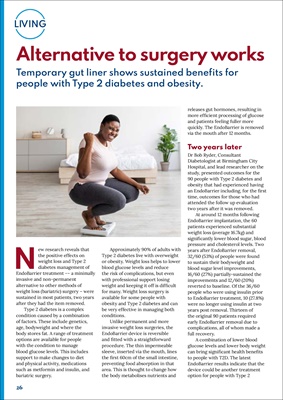
26
LIVING
Alternative to surgery works
Temporary gut liner shows sustained benefits for
people with Type 2 diabetes and obesity.
New research reveals that
the positive effects on
weight loss and Type 2
diabetes management of
EndoBarrier treatment -- a minimally
invasive and non-permanent
alternative to other methods of
weight loss (bariatric) surgery - were
sustained in most patients, two years
after they had the item removed.
Type 2 diabetes is a complex
condition caused by a combination
of factors. These include genetics,
age, bodyweight and where the
body stores fat. A range of treatment
options are available for people
with the condition to manage
blood glucose levels. This includes
support to make changes to diet
and physical activity, medications
such as metformin and insulin, and
bariatric surgery.
Approximately 90% of adults with
Type 2 diabetes live with overweight
or obesity. Weight loss helps to lower
blood glucose levels and reduce
the risk of complications, but even
with professional support losing
weight and keeping it off is difficult
for many. Weight loss surgery is
available for some people with
obesity and Type 2 diabetes and can
be very effective in managing both
conditions.
Unlike permanent and more
invasive weight loss surgeries, the
EndoBarrier device is reversible
and fitted with a straightforward
procedure. The thin impermeable
sleeve, inserted via the mouth, lines
the first 60cm of the small intestine,
preventing food absorption in that
area. This is thought to change how
the body metabolises nutrients and
releases gut hormones, resulting in
more efficient processing of glucose
and patients feeling fuller more
quickly. The EndoBarrier is removed
via the mouth after 12 months.
Two years later
Dr Bob Ryder, Consultant
Diabetologist at Birmingham City
Hospital, and lead researcher on the
study, presented outcomes for the
90 people with Type 2 diabetes and
obesity that had experienced having
an EndoBarrier including, for the first
time, outcomes for those who had
attended the follow up evaluation
two years after it was removed.
At around 12 months following
EndoBarrier implantation, the 60
patients experienced substantial
weight loss (average 16.7kg) and
significantly lower blood sugar, blood
pressure and cholesterol levels. Two
years after EndoBarrier removal,
32/60 (53%) of people were found
to sustain their bodyweight and
blood sugar level improvements,
16/60 (27%) partially-sustained the
improvements and 12/60 (20%)
reverted to baseline. Of the 36/60
people who were using insulin prior
to EndoBarrier treatment, 10 (27.8%)
were no longer using insulin at two
years post removal. Thirteen of
the original 90 patients required
early EndoBarrier removal due to
complications, all of whom made a
full recovery.
A combination of lower blood
glucose levels and lower body weight
can bring significant health benefits
to people with T2D. The latest
EndoBarrier results indicate that the
device could be another treatment
option for people with Type 2